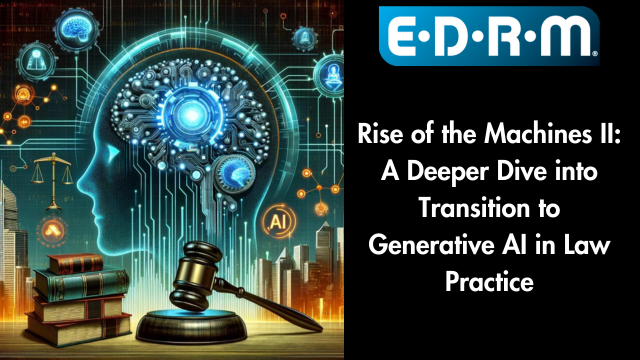
[Editor’s Note: EDRM is proud to publish the Hon. Ralph Artigliere’s (ret.) advocacy and analysis. The opinions and positions are Judge Artigliere’s (ret.) March 21, 2024 © Ralph Artigliere. This article was written for the second edition fireside chat on “Rise of the Machines II: Unleash the Power of AI for a Future-Proof Legal Practice” which will be hosted on the EDRM Global Webinar Channel on April 16, 2024. Information about the fireside chat and complimentary registration may be found here.]
Two things that separate great lawyers from good lawyers are PROFICIENCY and EFFICIENCY. These characteristics enable delivery of excellent work product at a reasonable and therefore competitive cost to the client. Great lawyers as individuals and managers constantly improve their work quality and workflow and enhance the quality and workflow of their team or firm. The emergence of generative AI stands to assist with both objectives. The key to successful augmentation through AI is understanding when and how to employ emerging technology.
In a sense, generative AI, properly used, can assume the role of providing checklist-type critical analysis to ensure complete and accurate process and product.
The Hon. Ralph Artigliere (ret.)
In our first Rise of the Machines presentation, Shawn Arnold and I explored how AI is transforming legal practice. Shawn outlined the specific strengths of Generative AI and how its power can be used in specific applications in legal practice. We also visited the potential pitfalls and concerns that have been legitimately raised about hallucinations, client confidentiality, and bias. With the proliferation of AI tools, platforms, and services, we began discussing ways that lawyers and their firms can avoid being overwhelmed by the choices and challenges of choosing products that fit their needs and budget. Basically, we talked about what GenAI products are and what they can do for lawyers to help workflow and performance. We addressed why it is beneficial for lawyers and firms to make the transition to AI and began discussing how to make the transition safely and efficiently.
Covering this material in one hour is challenging, and we found from the response to the first program that we have more to offer with a second program and a deeper dive into the subject of transitioning to emerging platforms. The response to the program was extremely positive, and Shawn agreed to join me again to delve into practical implications and strategies for leveraging generative AI to advance the conversation for our audience. In the next installment, we intend to discuss how to capitalize on the power of generative AI together with human input and other available AI, such as machine learning, computer assisted review, and writing enhancement products to raise efficiency and performance in workflow and output. We will also discuss some of the cautionary guardrails needed to safely negotiate the space as legal professionals.
Generative AI helps the user be more creative and think outside the box. One of the challenges for any human is not having tunnel vision or bias on direction based on perceived answers or expected paths and answers. We all need challenges to our thought processes to be open minded and better executive thinkers. In a sense, generative AI, properly used, can assume the role of providing checklist-type critical analysis to ensure complete and accurate process and product. Shawn will explain the power of generative AI as a lever to enhance performance in many tasks undertaken by legal professionals every day.
It is incumbent on lawyers as legal professionals and as managers to understand the technology they use or retain the assistance they need to properly use it. There are paths for lawyers to get the knowledge or assistance they need to accomplish this, but ways to do that are not always intuitive. Regrettably, the field is complicated because the power and facility of use of emerging legal AI products and services are either puffed or misrepresented by developers and sellers. Getting the right answers on product choice for a specific lawyer or firm requires either technical knowledge or guidance from qualified and reliable sources. More often than not, assigning responsibility for such analysis to a young lawyer, volunteer or not, is an inadequate path. I will ask Shawn how lawyers can source the information they need and the right questions to ask. I personally cannot wait to hear from Shawn on that subject.
Another area to explore further are the right questions and paths to ensuring security and confidentiality in the use of generative AI products and platforms.
The Hon. Ralph Artigliere (ret.)
Another area to explore further are the right questions and paths to ensuring security and confidentiality in the use of generative AI products and platforms. Products range from open and free platforms like OpenAI and Claude to legal specific large language model products and services, and the security questions necessary for safe and secure use vary accordingly. Are the providers going to train from your data? Are the inputs being logged for research or any other purpose? Are the prompts retained, and if so, for how long?
Questions pertinent to performance are also essential for effectiveness of the work product. Hallucinations are not the only potential issue, and all large language models are obviously not equal for a given task. Complicating the problem of selection is the fact that the competitive field keeps evolving because the industry is enormously competitive and development of products evolves constantly. While one product may have the edge today for a given application, competitors may eclipse them at any time. Reliable ratings are not easily accessible, and technical knowledge is needed to curate results that are available. I want to understand this better, so I will ask Shawn to help the audience and me with that issue.
Join Shawn and me for his answer to these and other key questions at 1 p.m. on April 16, 2024, for our next program. Sign up here.
March 21, 2024 © Ralph Artigliere. ALL RIGHTS RESERVED (Published on edrm.net with permission.)
NOTE: Generative AI products were used to help review this article per EDRM GAI and LLM Policy.


